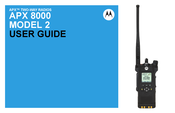Motorola APX 8000 2 Manuals
Manuals and User Guides for Motorola APX 8000 2. We have 2 Motorola APX 8000 2 manuals available for free PDF download: User Manual
Motorola APX 8000 2 User Manual (148 pages)
Brand: Motorola
|
Category: Two-Way Radio
|
Size: 1 MB
Table of Contents
-
Radio Care13
-
Securenet15
-
Status Icons28
-
Alert Tones35
-
Viqi47
-
Contacts55
-
Scan Lists57
-
Scan59
-
Recent Calls62
-
Fireground69
-
Man down72
-
Logging out75
-
Hear Clear89
-
Smartconnect98
-
Holster Sensor108
-
Wi-Fi114
-
Utilities116
-
Transmit Inhibit123
-
Disclaimer131
-
Copyrights131
-
Limited Warranty139
-
Glossary143
Advertisement
Motorola APX 8000 2 User Manual (174 pages)
Brand: Motorola
|
Category: Two-Way Radio
|
Size: 3 MB
Table of Contents
-
Disclaimer20
-
Securenet22
-
Home Button37
-
Status Icons40
-
Alert Tones48
-
Contacts71
-
Scan Lists73
-
Scan76
-
Man down86
-
GPS Operation108
-
Re-Pair Timer117
-
Wi-Fi136
-
Utilities137
-
Transmit Inhibit146
-
Helpful Tips151
-
Radio Care151
-
Battery Care153
-
Accessories156
-
Glossary161
-
Limited Warranty167

